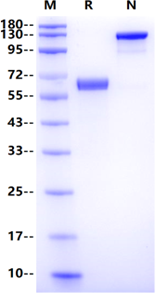Leu28-Gly232, with C-terminal Human IgG1 Fc
58-70kDa (Reducing)
>95% by SDS-PAGE&RP-HPLC
PBS, pH7.4
Reconstitute at 0.1-1 mg/ml according to the size in ultrapure water after rapid centrifugation.
· 12 months from date of receipt, lyophilized powder stored at -20 to -80℃.
· 3 months, -20 to -80℃ under sterile conditions after reconstitution.
· 1 week, 2 to 8℃ under sterile conditions after reconstitution.
· Please avoid repeated freeze-thaw cycles.
There are two subfamilies of Ephrins, Ephrins-As (Ephrin-A1 to A10), and Ephrins-Bs (Ephrin-B1 to B6), binding to the tyrosine receptor kinases EphAs and EphBs, respectively. Ephrins-As have a GPI-anchor at their C-terminus. Ephrin-B ligands are transmembrane proteins. The extracellular region of Eph receptors (there are 10 EphAs and 6 EphBs in vertebrates) consists of an N-terminal Ephrin-binding domain, a cysteine-rich region (EGF-like motif) and two fibronectin type-III motifs. A juxtamembrane segment, a tyrosine kinase domain, a sterile-α-motif (SAM), and a PDZ binding motif are part of the intracellular region of the Eph receptors and are involved in bidirectional (forward and reverse) signaling through the small GTPases Rac, cdc42, and Rho. Ephrins/Ephs have many different physiological roles, such as cell adhesion, cell migration, and axon guidance. During development of the CNS, Ephrins mainly act as axon repellants in different areas, including the optic tectum, the anterior commissure, and the corticospinal tract (CST). Ephrins/Ephs play an important role in the regulation of synapse formation, function, and plasticity. Furthermore, Ephrins/Ephs are important in adults for the maintenance of synapses, cell proliferation, neurogenesis, and apoptosis in the rostral migratory stream and subventricular zone. In vitro, Ephrins exhibit activities in growth cone collapse and axon growth inhibition for many different neuronal types. After CNS injury in vivo, many Ephrins/Ephs are upregulated. For example, after spinal cord injury, EphA3, A4, A6, and A8, EphB3, EphB2, and Ephrin-B2 expression levels are increased, raising the possibility that they may contribute to the lack of axon regeneration. The ephrin-B-EphB family plays a critical role in the maintenance of bone homeostasis. Ephrin-Eph signaling is bidirectional; thus, the binding between ligand and receptor triggers a signal transduction cascade downstream of both molecules. The bidirectional nature of ephrin-Eph signaling is the basis of its role in coupling bone resorption to bone formation. Osteoblasts express both ephrin-A and B ligands and EphA and EphB receptors, whereas osteoclasts express only ephrins A2, B1, and B2, with no detectable EphB or EphA1, EphA2, and EphA4 receptors. Osteocytes also express EphB4 and ephrins B1 and B2.
